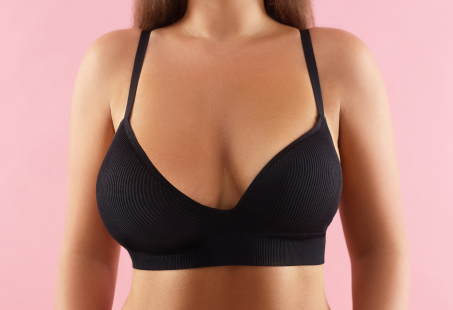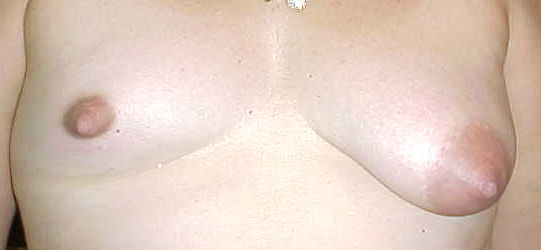Even though many people have a degree of breast asymmetry, when breasts are dramatically different in shape, size, or position, it can contribute to feelings of self-consciousness. It may also cause body image issues with the person not feeling comfortable enough in their skin.
While a person’s genetics can influence how the breasts, nipples and areola shape, it should also be noted that sometimes breast asymmetry is acquired. Depending on the underlying cause of the problem, it may or may not be permanent.
Things like padded bras and bra inserts might provide temporary camouflage, but some people seek more long-term solutions in plastic surgery. In this guide, you’ll learn more about the different treatment options for breast asymmetry and what can cause it in the first place.
What Is Breast Asymmetry?
Breast asymmetry, as the name suggests, is a condition in which the volume, shape, and position of the breasts are not identical to each other. It may also be possible for breasts to look asymmetrical if the nipples and areolas are positioned or sized differently. Similarly, if one breast sags more than the other, it can look uneven.

It should, however, be noted that according to a study published in the Annals of Plastic Surgery, there exists a natural asymmetry in the breasts. The researchers also noted that the left breast, on average, bigger than the right one. It’s possible that the difference is too small for you to even notice. Either one or both of the breasts may be affected in a way that’s causing this problem.
What Causes Breast Asymmetry?
Breast asymmetry causes may include the following:
Polymastia
According to a study published in ePlasty, polymastia is a congenital breast asymmetry condition which results in the formation of an “accessory breast” in addition to the ones you already have. According to the researchers, both men and women can have polymastia, although the incidence is higher among women (2-6%) than men (1-3%). One of the consequences of the presence of polymastia is that it can cause asymmetry.
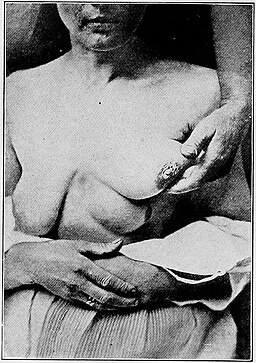
Amastia
Amastia is kind of the opposite of polymastia in that the breasts, along with the nipples and areolas, are absent. So, the entire breast(s) can be missing. It’s another congenital condition that can result in markedly asymmetrical breasts. It can be bilateral, meaning it affects both breasts or unilateral, meaning it affects only one breast, according to a 2021 study published in Cureus.
Amazia
In amazia, the nipple-areola complex is present, but the mammary gland is missing, according to a study published in the Journal of Pediatric and Adolescent Gynecology. It can occur on its own or as a part of another genetic condition. It can also affect one or both breasts and make the breasts look uneven.
Athelia
Athelia is also a congenital condition although it can also be acquired as a result of injury or surgical removal. It is characterised by the absence of the nipple and the areola. It can also affect either one or both breasts, can occur in both men and women and may also cause breast asymmetry.
Tubular Breasts
Breast asymmetry can also be the result of tuberous/tubular breasts or breast hypoplasia, which is when the breasts are underdeveloped due to insufficient glandular tissue.
According to a 2013 study in Seminars in Plastic Surgery, this condition can be congenital or acquired (e.g. as a result of radiation during childhood) and can occur on its own or in association with certain other syndromes and deformities of the chest wall. Its cause isn’t always known.
Juvenile Breast Hypertrophy
Juvenile breast hypertrophy, also known as virginal breast hypertrophy, juvenile gigantomastia/macromastia, is a rare condition which results in rapid and excessive growth of the breasts in women around the time of puberty.
According to a 2013 study published in the Seminars in Plastic Surgery, the exact cause of this condition is not known, however, hypersensitivity to gonadal (reproductive organs’) hormones and “increased hormone activity” have been theorised.
The condition can also affect one or both breasts and, as per a 2023 case report in Cureus, can affect children between the ages of 10-17 so it can cause breast asymmetry in teenagers and young children.
Poland Syndrome
The British Association of Plastic Reconstructive and Aesthetic Surgeons (BAPRAS) reports that Poland syndrome, a rare, congenital condition, can also result in breast asymmetry. It can result in abnormalities in the development of breast tissue on one side. The development of chest wall muscles is affected as well, among other symptoms.
Scoliosis
Scoliosis is a condition that results in an abnormal curvature of the spine, but it can also make the breasts asymmetrical.
Differences in the volume of the breast and “thoracic deformation” from scoliosis can result in this asymmetry, per a study in the Journal of Plastic, Reconstructive & Aesthetic Surgery. The exact cause of the most commonly occurring scoliosis is not known, although genetics have been implicated.

Breast Infection
As reported in the European Journal of Breast Health, “recurrent infections, TB, and granulomatous mastitis” can deform the breasts. Therefore, they can also contribute to asymmetry. “Recurring mastitis” – which refers to the inflammation of the breast tissue – is also reported to cause long-term inflammation, changing the appearance of the breasts.
Diabetic Mastopathy
Diabetic mastopathy is a rare condition that, as the name suggests, can occur as a complication of diabetes. As reported by diabetes.co.uk, the condition results in the formation of benign “tough masses” in the breasts. It’s most often reported in women with Type 1 diabetes, but men can also develop it. Both men and women can be affected by it, and it can make the breasts look asymmetrical.

Breast Cancer
Unfortunately, breast cancer is another reason why breasts can become asymmetrical. A 2006 study in Breast Cancer Research even assessed the relationship between breast asymmetry and predisposition to breast cancer.
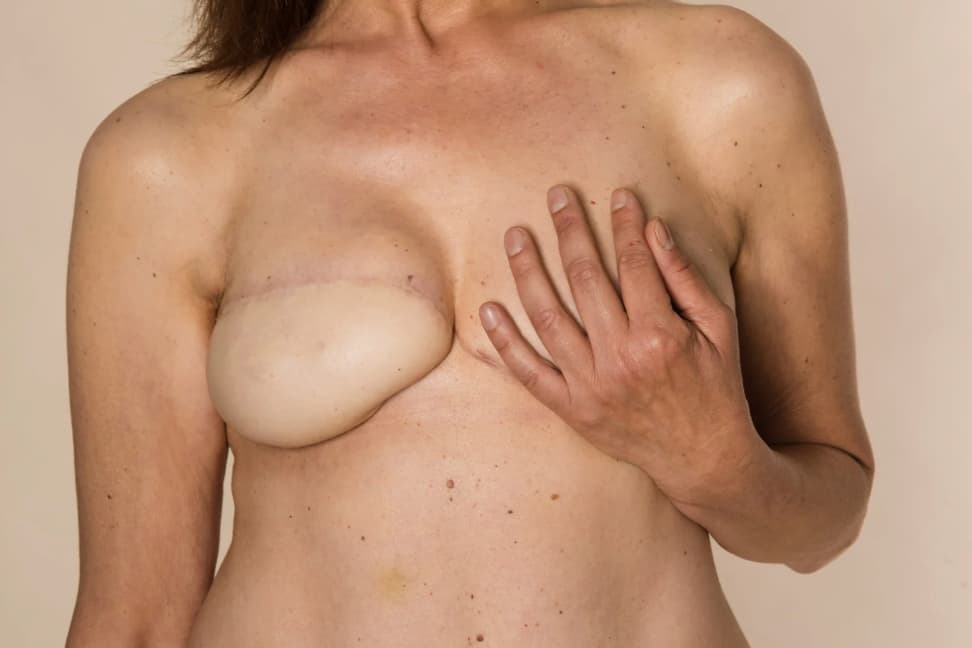
It concluded that healthy women who later developed breast cancer had greater breast asymmetry than those who didn’t. Conditions like atypical ductal hyperplasia, which affects the milk ducts and is itself benign, may also increase the risk of breast cancer.
Regular breast self-exams and screenings are usually advised to check for any changes in breasts, and if you notice anything different or not normal, you should immediately get in touch with your doctor.
Breast Reconstruction
According to Breastcancer.org, both the reconstruction of the breasts and radiation therapy can result in breast asymmetry. The breasts can get firmer and go higher up following radiation therapy. For this reason, it might be advised that you delay breast reconstruction until after the radiotherapy is completed.
Pregnancy and Breastfeeding
Both pregnancy and breastfeeding can cause the volume of the breasts to change in a way that might affect their overall symmetry. The hormonal changes during pregnancy can change how your breasts look.

Also, for instance, during nursing, if the baby prefers one breast over the other, one breast has more milk than the other, etc., it can become lopsided, as per the Australian Breastfeeding Association. However, they also say that, eventually, as the baby discontinues breastfeeding, the breasts will even out.
What Are The Symptoms Of Breast Asymmetry?
Breast asymmetry symptoms can vary depending on the underlying cause of the problem.
For instance, in the case of polymastia, besides the presence of an accessory breast, a patient might experience swelling and tenderness, some physical issues along with “irritation from clothing,” according to the ePlasty research. The researchers also note that both pregnancy and puberty can worsen the symptoms. Also, of note is that breast cancer has been reported in the accessory breast as well, which is why you must get yourself checked regularly.
In amastia, the condition can occur “isolated,” which means that it’s not related to another medical condition. In this case, you might have unilateral or bilateral absence of breast (with the nipple and areola). However, if it occurs as a part of another illness, the symptoms can vary according to it.
In the case of amazia, as reported in the case study in the Journal of Pediatric and Adolescent Gynecology, the condition can occur on its own or congenitally, where it can be accompanied by other symptoms, such as saddle nose, cleft palate, high-arched palate, etc.
As far as congenital athelia is concerned, it can occur due to different conditions like Poland syndrome, Yunis Varon syndrome, Al Awadi/Raas–Rothschild syndrome, certain ectodermal dysplasias, etc. So, depending on the illness you have, the symptoms accompanying athelia can change.
Tubular breasts, on the other hand, can be characterised by the presence of asymmetry itself, along with other symptoms like a gap of 1.5 inches between the breasts, tube-like, oval, pointed, triangular or square-shaped breasts, and large areolas, among others. You must consult a professional for an accurate diagnosis.
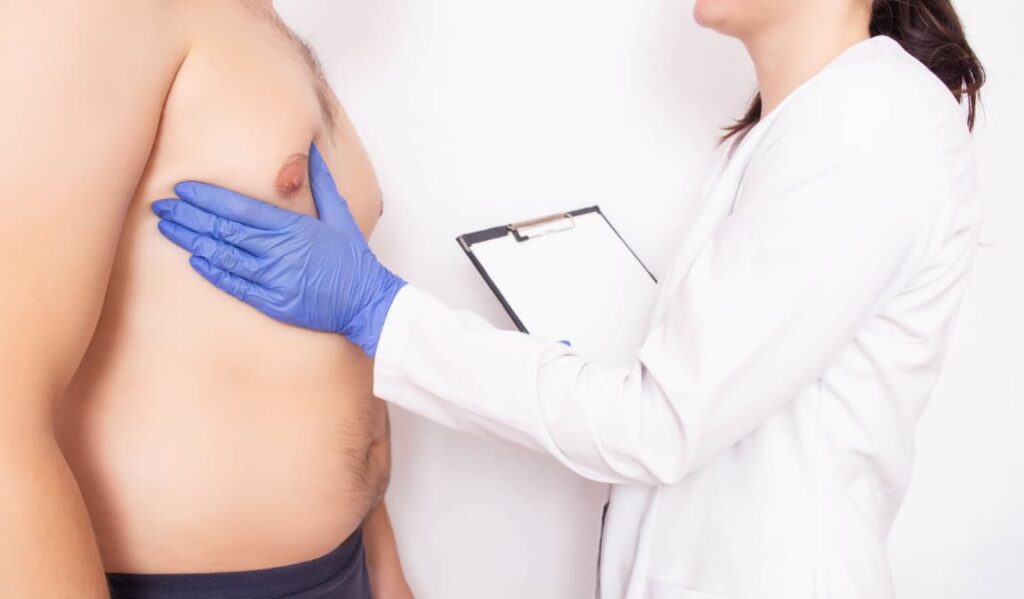
With juvenile breast hypertrophy, since patients experience excessive growth of the breasts, the condition can be accompanied by many physical discomforts. According to a 2023 study published in Cureus, juvenile macromastia can be accompanied by symptoms such as pain in the breasts, neck and back, bra strap grooving, difficulty in performing physical activities, etc. Psychological effects can also include poor body image, “low self-esteem, and emotional distress.”
Following that, in Poland syndrome, besides chest and breast abnormalities, patients can have issues with their ribs, shoulder muscles, hand and forearm bones, and have issues with other organs, such as the heart or lungs, etc.
On the other hand, with scoliosis, patients can experience symptoms such as having uneven shoulders, being tilted to one side more than the other, hip being higher on one side, and a rib hump.
In the case of mastitis, the symptoms can include swelling of the breasts, pain, tenderness, redness, burning sensation, hard lumps, chills, and fever. And as far as diabetic mastopathy goes, the symptoms can include hard lumps, which can be painless and irregular. Of course, if you have a breast lump, you must consult a medical professional for accurate diagnosis. This condition is often confused with breast cancer.
For breast cancer, you should look out for any changes in the shape and size of your breasts, lumps, swelling or lump in armpits, changes in the appearance of the skin, nipple looking different, scaliness, itchiness, crusting, or a rash around the nipple, among others, according to the NHS.
No matter what, keep in mind that you must get in touch with a medical professional for a proper diagnosis of your condition.
Can Breast Asymmetry Be Corrected?
Breast asymmetry correction is possible. Depending on the underlying cause of the problem, it might fix itself (like in the case of breastfeeding), but in other instances, surgical intervention might be recommended through procedures such as breast implants, fat transfer, breast reduction, or breast lift. Only your doctor can best advise you on the most effective treatment plan for you.
How Is Breast Asymmetry Treated?
Treatment for breast asymmetry can vary depending on why you have the asymmetry in the first place. In general, the treatment options for breast asymmetry might include the following:
Breast Augmentation
Several conditions, including amastia, amazia, tubular breasts, and Poland syndrome, can include breast augmentation with implants as a potential treatment option for breast symmetry surgery.
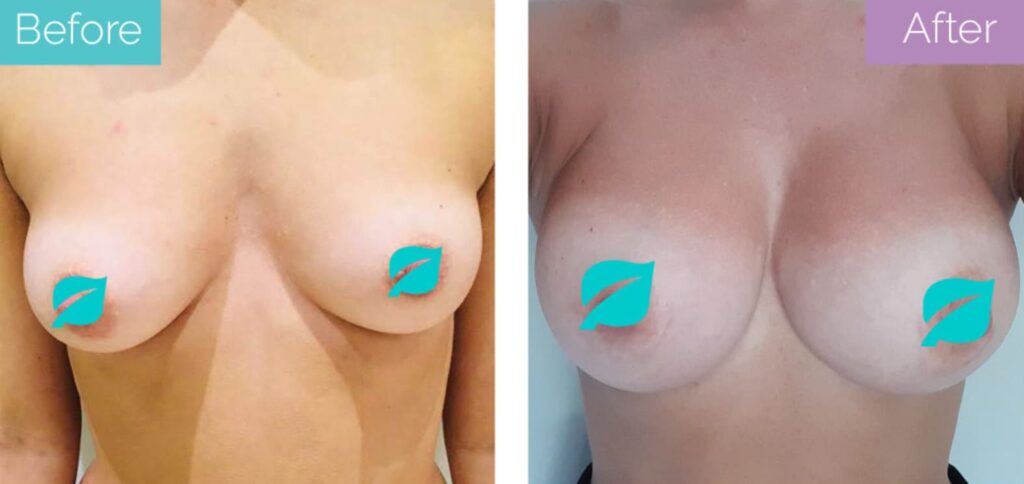
Depending on your needs, the surgeon might recommend a unilateral implant surgery (for instance, an implant is placed in the smaller breast to match it with the bigger one if that’s what you want), or it could involve placing implants in both breasts. These implants’ volume, projection, widths, etc., can be different for each breast to make sure that symmetry (as best as possible) is achieved for the patient.
But keep in mind even BAPRAS states that “perfect symmetry is not an achievable goal,” and it’s “normal” to have a small degree of this difference between breasts. Asymmetry after surgery can also arise due to factors such as body changes (pregnancy or weight fluctuations), problems with implants (rupture, capsular contracture, etc.), or surgical errors. Regular self and clinical exams are usually recommended by doctors.
Fat Transfer
Breast augmentation can also be done with fat transfers. It may even be combined with implants. However, with lipofilling alone, one problem is that the fat may be reabsorbed by the body, and the results might change after some time. It might not be as dramatic either. Still, it has been done successfully to improve breast asymmetry.
Breast Reduction
Asymmetry breast reduction procedure can also help you achieve breast symmetry, especially in conditions where one breast is unilaterally enlarged, as might happen in Poland syndrome or juvenile breast hypertrophy. In this case, the larger breast may be reduced to match the smaller one. Further, lipofilling and/or implants might be used to achieve symmetry.
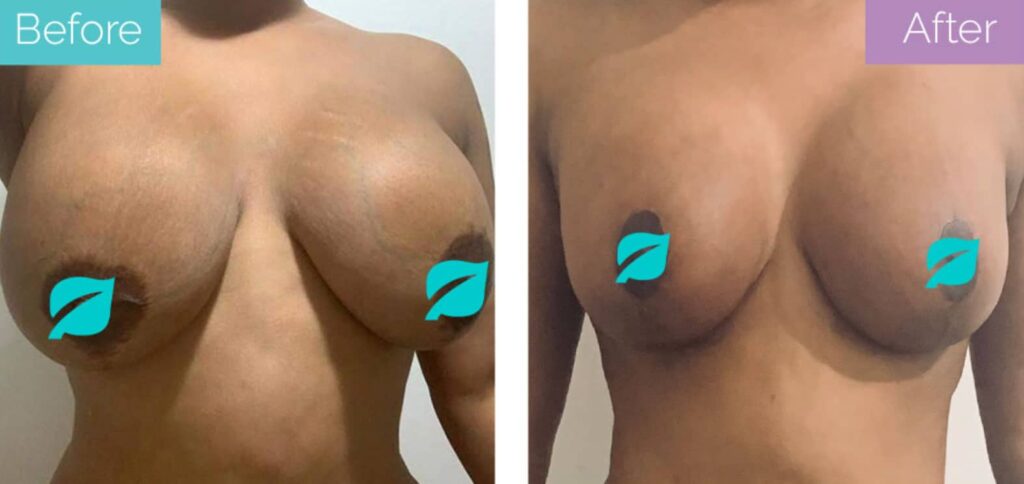
Breast Lift
Breast ptosis or sagging can also make the shape and size of your breasts look different from each other. Therefore, a breast lift can be another breast asymmetry treatment which can help you get rid of excess skin and tighten the tissues to reshape the breasts entirely. It also includes repositioning of the nipple-areola complex.
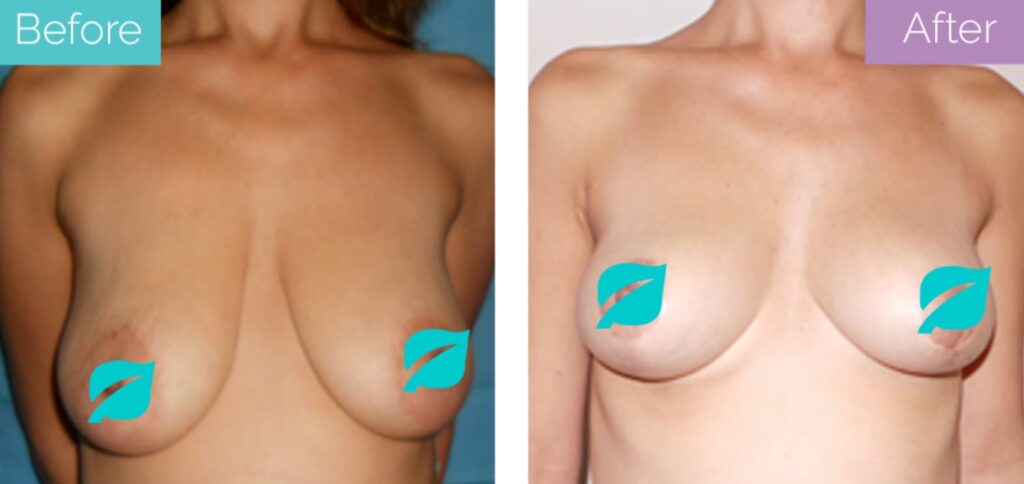
Other Treatments
The answer to how to fix breast asymmetry isn’t always breast augmentation, reduction or lift. For instance, in the case of polymastia, where there’s an accessory breast, the treatment can involve cutting it out and/or suctioning the fat out with liposuction.
Similarly, while athelia may also need breast reconstruction, the nipple-areola will require separate treatment. Even a tattoo might be recommended to you by your doctor for adding colour to the new nipple and areola or just to create the illusion of a nipple if you don’t have surgery.
Also, for example, tubular breast treatment can include areola reduction. Since this condition can result in the formation of abnormally large areolas, improvement in the overall aesthetics may also be achieved with the help of areola reshaping surgery.
In the case of juvenile breast hypertrophy, it largely depends on the case of the patient, one treatment option might include mastectomy to reduce the risk of the condition from developing again. Mastectomy can be followed by the reconstruction of the breast with implants.
Other than that, if your asymmetry is the result of an issue with your pre-existing implants, a replacement surgery can be a potential treatment option.
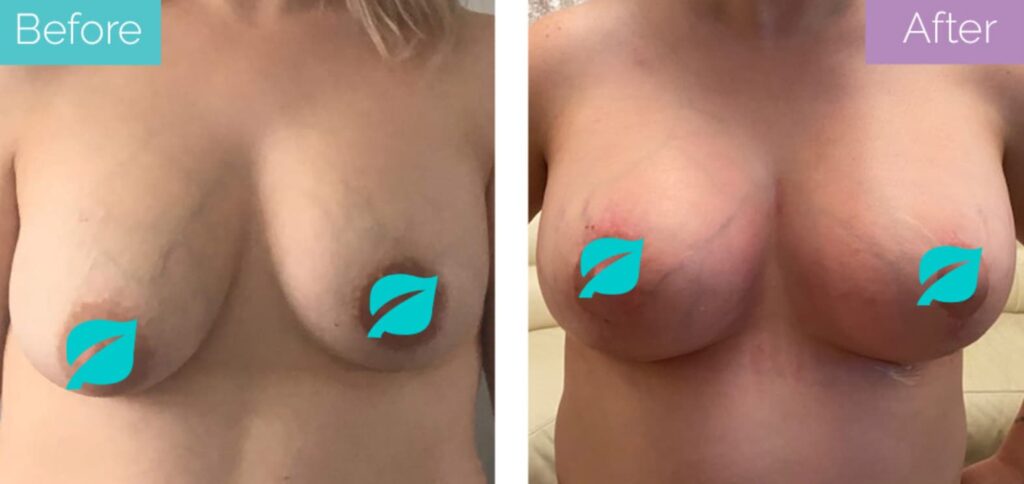
Breast illnesses can require a combination of different treatments. Therefore, treatment options can largely vary, and only a board-certified medical professional can best advise you on them. You must consult them in this regard,
Under What Conditions Is Breast Asymmetry Surgery Performed?
Breast asymmetry surgery can be performed for both medical and cosmetic reasons. In medical cases, you might be able to avail of the surgery on public health services or insurance. But if it’s purely for cosmetic reasons, you might have to get it privately.
If you’re considering getting treatment for breast asymmetry on the NHS, the best person to advise you on the local rules would be your GP. Things like how marked the differences between your breasts might be considered, body mass index, your lifestyle, other physical discomforts, etc.
The newly formed Integrated Care Boards (ICBs) decide on the allocation of the budget of the NHS. For procedures that are not routinely offered, an individual funding request can be made (IFR).
In the case of insurance, you must ask your insurance provider if it’s covered. It’s also possible that you have to get breast asymmetry treatment by a private surgeon.
Conclusion
Breast asymmetry can cause physical and psychological discomfort, especially if it’s quite noticeable. Depending on how severe it is and any accompanied symptoms, it might even make it difficult for you to fit into your clothes.
Some of the causes of breast asymmetry and their symptoms are mentioned above, but you must always consult a medical doctor for a diagnosis and a treatment plan for your concerns and goals.
Reviewed and approved by Prof Dr Fuat Yuksel
FAQ
How common is breast asymmetry?
Breast asymmetry is fairly common. You might have it without even noticing. However, it can become a source of concern when the difference between the breasts is quite significant.
Can menopause cause breast asymmetry?
Breast asymmetry in menopause may occur as a result of the hormonal changes that accompany the process and weight gain.
Can weight gain cause breast asymmetry?
The breasts are mostly made up of fatty tissue and gaining weight or even losing it might also result in breast asymmetry.
Does breast asymmetry go away?
In certain instances like breastfeeding, the breast asymmetry might go away on its own. However, for others, you might need treatment.
Is breast asymmetry normal?
Breast asymmetry can be normal. The breasts aren’t always necessarily identical. However, you should get yourself checked regularly, and if you notice anything different about your breasts, make sure to get in touch with a doctor immediately.
